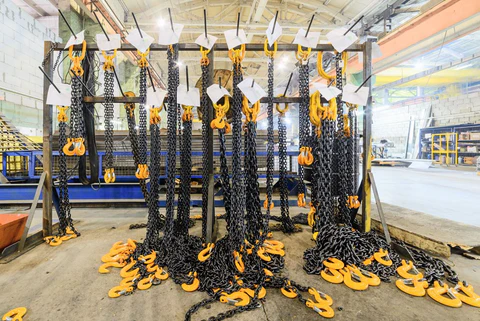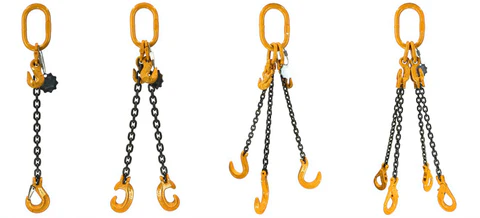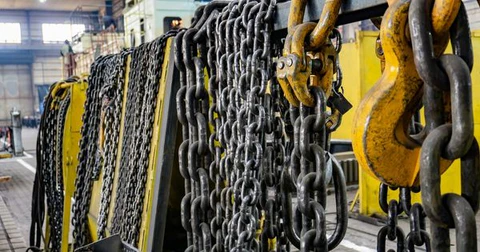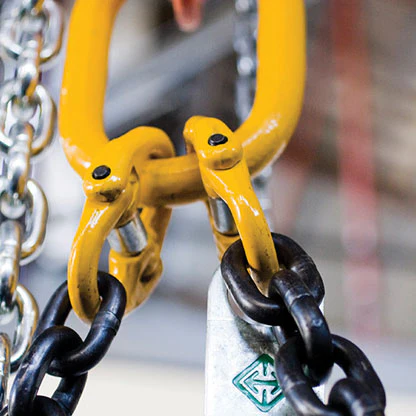The Ultimate Guide to Chain Slings
Chain slings are a fundamental component in lifting and rigging operations, providing a strong, durable, and reliable way to move heavy loads. Whether you're working on a construction site, in a manufacturing plant, or during transportation, chain slings are essential tools that ensure safety and efficiency. This guide will take you through the basics of chain slings, their importance, how to choose the right one for your needs, proper handling techniques, and essential maintenance practices.

Understanding the Basics of Chain Slings
At their core, chain slings are made from high-quality alloy steel chains designed to withstand heavy weights and harsh conditions. They consist of interlocked links that form a flexible yet strong lifting system. These slings have been used for centuries, evolving from simple metal chains into highly engineered tools that meet modern industrial demands.
One of the key advantages of chain slings is their resistance to abrasion, impact, and heat. This makes them ideal for environments where loads may be sharp, hot, or rough. Their flexibility also allows them to conform to different load shapes, ensuring a secure and balanced lift every time.
What Are Chain Slings?
Chain slings are versatile lifting devices used across various industries such as construction, shipping, and manufacturing. They are especially useful when dealing with heavy, awkward, or irregularly shaped objects. Unlike wire rope slings, chain slings offer better resistance to cutting and wear, making them a safer option in certain applications.
They come in different configurations, including single-leg, double-leg, triple-leg, and four-leg slings. Each type is designed for specific lifting scenarios, offering varying levels of stability and control. Choosing the right configuration depends on factors like load weight, lifting angle, and environmental conditions.
Types of Chain Slings
Single-leg slings are best suited for vertical lifts, while multi-leg slings provide more balance and support for complex lifts. The number of legs in a sling determines its ability to distribute weight evenly, which is crucial for maintaining stability and preventing accidents.

The Importance of Chain Slings in Lifting Operations
Chain slings play a critical role in ensuring the safety of both workers and equipment during lifting tasks. Their strength and durability make them ideal for heavy-duty applications, where failure could lead to serious injury or damage.
Proper use and regular inspection of chain slings can prevent accidents and extend their service life. In industries where precision and reliability are paramount, chain slings are often preferred over other lifting solutions due to their predictable performance and long lifespan.
Role in Heavy Lifting
When lifting large machinery, structural components, or heavy materials, chain slings provide the necessary strength and control. Their design allows them to handle extreme forces and maintain stability, even under challenging conditions. Whether it's a horizontal lift or a vertical hoist, chain slings are built to perform consistently and safely.
Safety Considerations
Safety should always be the top priority when using chain slings. Workers must be trained in proper handling techniques, and all slings should be inspected regularly for signs of damage. It's important to follow manufacturer guidelines regarding load limits and usage, as exceeding these can lead to catastrophic failures.
Maintenance is equally important. Lubricating the chain links, checking for distortion, and replacing worn parts promptly can help avoid unexpected breakdowns. A well-maintained chain sling not only lasts longer but also performs more reliably in real-world conditions.
Selecting the Right Chain Sling for Your Needs
Picking the correct chain sling is essential for safe and efficient lifting. Several factors should be considered, including load weight, lifting angle, and environmental conditions. For example, if you're working in a high-temperature area, you'll need a sling that can withstand heat without losing strength.
Additionally, the shape and material of the load matter. Sharp edges may require special protective sleeves or padding to prevent damage to the chain. If the load is frequently moved, a more durable and easily handled sling might be necessary.
Key Factors to Consider
Load capacity is one of the most important factors. Each chain sling has a rated working load limit (WLL), and exceeding this can be extremely dangerous. It's also important to consider the lifting angle, as this affects the actual stress on the sling. A 90-degree angle typically results in less strain than a 30-degree angle.
Environmental factors such as exposure to chemicals, moisture, or extreme temperatures should also be taken into account. Some chain slings are designed for harsh environments, while others are more suitable for indoor or controlled settings.
Understanding Load Capacity and Sling Length
Knowing the load capacity of your chain sling is crucial for safe operation. Always refer to the manufacturer’s load charts and never assume that a sling can handle more than its rated limit. Similarly, the length of the sling should be appropriate for the task at hand—too short and it may not allow for a stable lift, too long and it could become unstable or unsafe.
Regular inspections and maintenance are essential for ensuring the sling remains in good condition. Even the best chain sling can fail if not properly maintained, so it's important to build a routine for checking and servicing your equipment.

Proper Use and Handling of Chain Slings
Proper handling of chain slings is essential to maximize their lifespan and ensure safe operation. Training and awareness are key to preventing accidents and equipment damage. Workers should be familiar with the correct procedures for attaching, lifting, and releasing loads using chain slings.
Basic Operating Procedures
Before using a chain sling, always inspect it for signs of wear, such as stretched links, cracks, or corrosion. Attach the sling securely to the load, ensuring that it is balanced and that the lifting angle is within the recommended range. Avoid sudden movements or jerking, as this can cause stress on the sling and increase the risk of failure.
Communication between team members is also important. Clear signals and coordination can prevent misalignment and reduce the chances of accidents. Using additional lifting tools, such as shackles or hooks, can further enhance the safety and efficiency of the operation.
Do's and Don'ts of Handling Chain Slings
Some do’s include: inspecting the sling before each use, storing it properly when not in use, and lubricating the links regularly. Following the manufacturer’s recommendations for load limits and usage is also crucial.
On the flip side, some don’ts include: overloading the sling, twisting or knotting the chain, and exposing it to corrosive substances without protection. These actions can weaken the sling and significantly increase the risk of failure.

Maintenance and Inspection of Chain Slings
Regular maintenance and thorough inspections are vital to keeping chain slings in optimal condition. Neglecting these steps can lead to unexpected failures, which can be dangerous and costly.
Inspection and Maintenance Practices
Trained personnel should conduct regular inspections of chain slings, looking for signs of wear such as elongation, deformation, or damage to links and fittings. Any damaged components should be replaced immediately. Cleaning and lubricating the chain links can help prevent rust and ensure smooth operation.
Identifying Signs of Wear and Tear
Common signs of wear include stretched links, visible cracks, and corrosion. These issues can compromise the strength and integrity of the sling, increasing the risk of failure. If any of these signs are present, the sling should be removed from service and inspected by a qualified professional.
Conclusion
In conclusion, chain slings are an essential part of any lifting operation, offering strength, flexibility, and reliability. Understanding their function, selecting the right type for your needs, and following proper handling, maintenance, and inspection procedures are all key to ensuring safe and efficient lifting. By investing in quality chain slings and maintaining them properly, you can protect both your workers and your equipment, while maximizing productivity and minimizing risks.
Air cooled heating system, air cooled induction heating equipment, air cooled induction heating power supply, air cooled induction heating machine
Ningbo Dedao Electronic Technology Co., Ltd , https://www.nbdedao.com